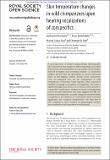Files in this item
Skin temperature changes in wild chimpanzees upon hearing vocalizations of conspecifics
Item metadata
| dc.contributor.author | Dezecache, Guillaume | |
| dc.contributor.author | Zuberbuhler, Klaus | |
| dc.contributor.author | Davila-Ross, Marina | |
| dc.contributor.author | Dahl, Christoph D. | |
| dc.date.accessioned | 2017-02-01T12:30:13Z | |
| dc.date.available | 2017-02-01T12:30:13Z | |
| dc.date.issued | 2017-01 | |
| dc.identifier | 248487643 | |
| dc.identifier | cbfdb39f-5ec0-40a3-8c10-6eb242d82b75 | |
| dc.identifier | 85010977472 | |
| dc.identifier | 000393395100042 | |
| dc.identifier.citation | Dezecache , G , Zuberbuhler , K , Davila-Ross , M & Dahl , C D 2017 , ' Skin temperature changes in wild chimpanzees upon hearing vocalizations of conspecifics ' , Royal Society Open Science , vol. 4 , 160816 . https://doi.org/10.1098/rsos.160816 | en |
| dc.identifier.issn | 2054-5703 | |
| dc.identifier.other | ORCID: /0000-0001-8378-088X/work/64360662 | |
| dc.identifier.uri | https://hdl.handle.net/10023/10210 | |
| dc.description | The authors are grateful to the Royal Zoological Society of Scotland for providing core funding to the Budongo Conservation Field Station. The research was supported by a Fyssen fellowship awarded to GD, funding from the European Union’s Seventh Framework Programme for research, technological development and demonstration (grant agreement no 283871), and the Swiss National Science Foundation (PZ00P3_154741) awarded to CDD. | en |
| dc.description.abstract | A growing trend of research using infra-red thermography (IRT) has shown that changes in skin temperature, associated with activity of the autonomic nervous system, can be reliably detected in human and non-human animals. A contact-free method, IRT provides the opportunity to uncover emotional states in free-ranging animals during social interactions. Here, we measured nose and ear temperatures of wild chimpanzees of Budongo Forest, Uganda, when exposed to naturally occurring vocalizations of conspecifics. We found a significant temperature decrease over the nose after exposure to conspecifics’ vocalizations, whereas we found a corresponding increase for ear temperature. Our study suggests that IRT can be used in wild animals to quantify changes in emotional states in response to the diversity of vocalizations, their functional significance and acoustical characteristics. We hope that it will contribute to more research on physiological changes associated with social interactions in wild animals. | |
| dc.format.extent | 10 | |
| dc.format.extent | 1223911 | |
| dc.language.iso | eng | |
| dc.relation.ispartof | Royal Society Open Science | en |
| dc.subject | Infra-red thermography | en |
| dc.subject | Skin temperature | en |
| dc.subject | Wild chimpanzees | en |
| dc.subject | Vocalizations | en |
| dc.subject | Emotions | en |
| dc.subject | BF Psychology | en |
| dc.subject | DAS | en |
| dc.subject.lcc | BF | en |
| dc.title | Skin temperature changes in wild chimpanzees upon hearing vocalizations of conspecifics | en |
| dc.type | Journal article | en |
| dc.contributor.institution | University of St Andrews. School of Psychology and Neuroscience | en |
| dc.contributor.institution | University of St Andrews. Institute of Behavioural and Neural Sciences | en |
| dc.contributor.institution | University of St Andrews. Centre for Social Learning & Cognitive Evolution | en |
| dc.identifier.doi | 10.1098/rsos.160816 | |
| dc.description.status | Peer reviewed | en |
| dc.date.embargoedUntil | 2017-01-25 |
This item appears in the following Collection(s)
Items in the St Andrews Research Repository are protected by copyright, with all rights reserved, unless otherwise indicated.

